About
At the Biointegrated Materials and Engineering Lab (a.k.a., the Fermart Lab), we believe that materials science and engineering define the boundaries of technological progress and shape the nature of societies. Just as human epochs have been characterized by revolutions in material usage—from stone to bronze, iron, and silicon/plastic—so too will our coming era be defined by the integration of biological principles and living components into engineered systems. We have named this emerging period the “Biomaterial Age.”
In our laboratory, materials science provides both the conceptual basis for studying natural phenomena and the practical foundation for engineering applications. We study natural systems at molecular, cellular, and organismal scales, drawing on tools and insights from animal physiology, ecology, standardised materials testing (e.g., ASTM methods), software and robotics, and cellular and synthetic biology. From these investigations, we pursue two intertwined goals:
- Fundamental discovery: advancing the understanding of the molecular and mechanistic principles that underlie natural materials and biological function.
- Technological translation: embedding biological components, native designs, self-assembling biomolecules, and bioinspired processes into new materials, manufacturing systems, and devices.
Our research spans applications in medical engineering (e.g., biomaterials for implants or tissue interfaces), sustainability (biointegrated materials and circular manufacturing), and even planetary colonization (materials and production methods suited for off-planet life support, habitat construction, or extreme environmental conditions). We harness abundant naturally occurring molecules, their evolutionary architectures, and their native synthesis processes to generate materials and methods that integrate seamlessly into their host environments—whether the human body or an ecosystem.
The Biointegrated Materials and Engineering Lab is both the origin and the forefront of the Biomaterial Age, shaping a revolution in materials and manufacturing that has been recognized as “the future of manufacturing” and “the missing piece of the circular economy.”
Staff
Javier Gomez Fernandez
 ibecbarcelona.eu
ibecbarcelona.euCollaborations
- Massachusetts Institute of Technology, Harvard University, Wyss Institute, Singapore University of Technology and Design, National University of Singapore
News

El IBEC incorpora dos nuevos grupos de investigación
El Instituto de Bioingeniería de Cataluña (IBEC) ha dado la bienvenida este año a dos nuevos grupos de investigación liderados, respectivamente, por el Profesor de Investigación ICREA Javier G. Fernández y el Dr. Nicolò Accanto. El grupo de Materiales e Ingeniería Biointegrados, de Fernández, busca integrar principios biológicos y componentes vivos en sistemas de ingeniería, dando lugar a lo que denominan la ‘Era de los Biomateriales’. El grupo de Accanto, Fotónica No Lineal para Neurociencia, busca desarrollar tecnologías ópticas avanzadas que permitan desentrañar los mecanismos que rigen la actividad neuronal.

